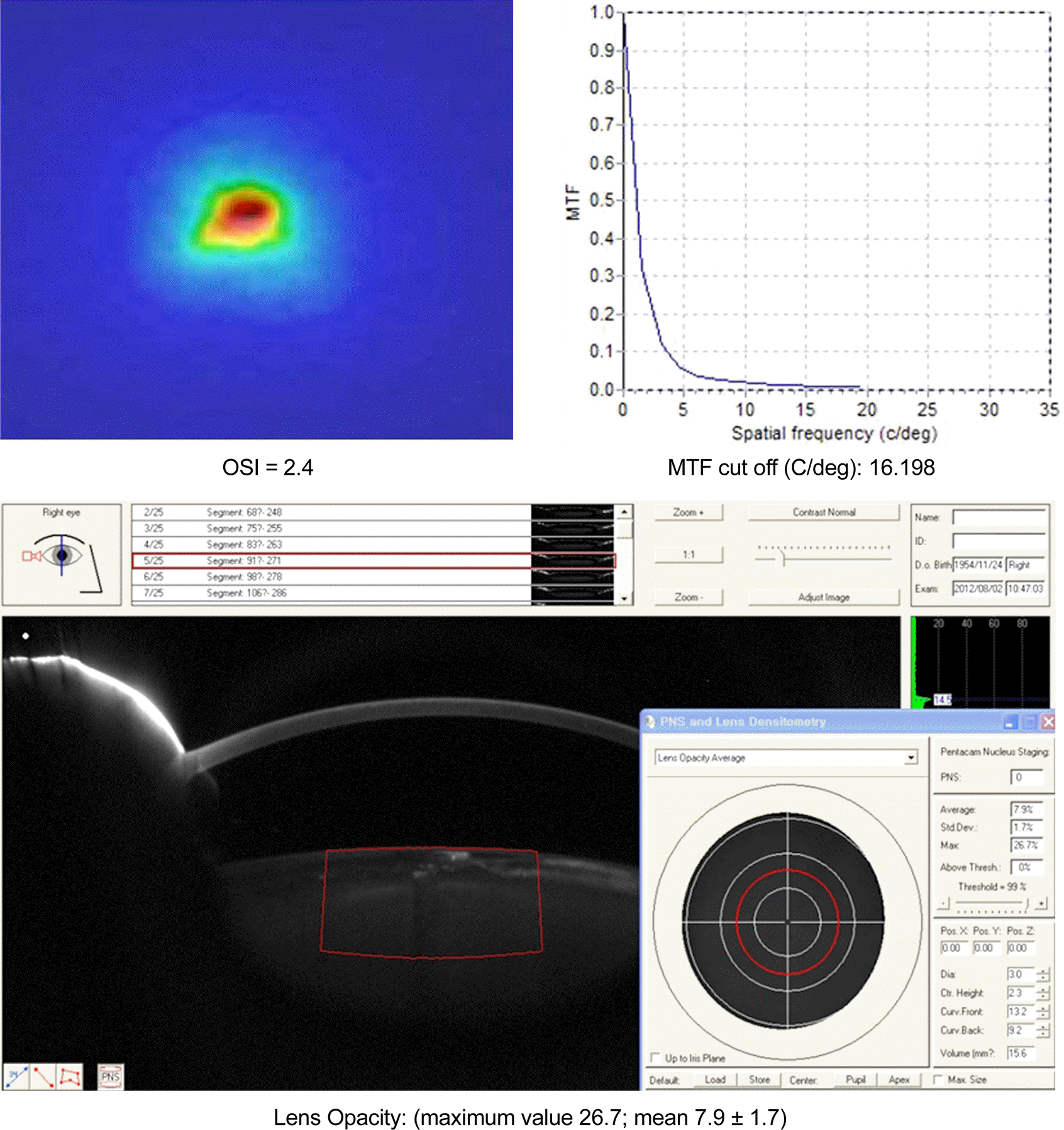Abstract
Purpose
To investigate the results using the OQAS and the Pentacam in cataract patients classified according to the type of lens opacity.
Methods
The present study included 124 eyes of 92 patients who had cataract surgery at Seoul St. Mary’s Hospital from December 2011 to January 2012 and were classified into nuclear, cortical, and posterior subcapsular cataract patients. The lens opacity was determined with OSI, MTF, Strehl ratio, width 10%, width 50% and the opacity of Scheimpflug image by the OQAS and the Pentacam. Additionally, the correlation between subjective cataract classification and objective opacity value was analyzed.
Results
The nuclear cataract group showed a 6.40 ± 2.41 OSI value and had high opacity. The cortical cataract group showed the highest MTF cut-off value (12.02 ± 6.19 C/deg). When evaluating Pentacam results, the posterior subcapsular cataract group had the lowest average level of lens opacity (9.12 ± 1.08) followed by in increasing order, the cortical cataract group (9.79 ± 1.67) and the nuclear cataract group (11.08 ± 1.84). The results were statistically significant (p < 0.001). The OSI value of the OQAS was significantly correlated with nuclear and posterior opacity (p = 0.049, p = 0.039, re-spectively) except cortical opacity (p = 0.781). MTF and nuclear opacity showed statistically significant correlation and the lens opacity of Pentacam was correlated with nuclear and posterior opacities. In cortical cataract with severe peripheral opacity, the cortical opacity showed significant correlation with Maximum.
Go to : 
References
1. Congdon N, West SK, Buhrmann RR. . Prevalence of the dif-ferent types of age-related cataract in an African population. Invest Ophthalmol Vis Sci. 2001; 42:2478–82.
2. Wu R, Wang JJ, Mitchell P. . Smoking, socioeconomic factors, and age-related cataract: The Singapore Malay Eye study. Arch Ophthalmol. 2010; 128:1029–35.
3. Miglior S, Marighi PE, Musicco M. . Risk factors for cortical, nuclear, posterior subcapsular and mixed cataract: a case-control study. Ophthalmic Epidemiol. 1994; 1:93–105.

4. Kim HJ.Prevalence of cataract with different type of lens opacity in the Korean population. J Korean Oph Opt Soc. 2013; 18:53–9.

5. Vilaseca M, Padilla A, Pujol J. . Optical quality one month af-ter verisyse and Veriflex phakic IOL implantation and Zeiss MEL 80 LASIK for myopia from 5.00 to 16.50 diopters. J Refract Surg. 2009; 25:689–98.

6. Benito A, Pérez GM, Mirabet S. . Objective optical assessment of tear-film quality dynamics in normal and mildly symptomatic dry eyes. J Cataract Refract Surg. 2011; 37:1481–7.

7. Artal P, Benito A, Pérez GM. . An objective scatter index based on double-pass retinal images of a point source to classify cataracts. PLoS One. 2011; 6:e16823.

8. Park CW, Lee YE, Joo CK.Changes in optical quality of cataract patients' corrected visual acuity before and after phacoemulsification. J Korean Ophthalmol Soc. 2013; 54:1208–12.

9. Pesudovs K, Elliott DB.Refractive error changes in cortical, nuclear, and posterior subcapsular cataracts. Br J Ophthalmol. 2003; 87:964–7.

10. Kim JS, Chung SH, Joo CK.Clinical application of a Scheimpflug system for lens density measurements in phacoemulsification. J Cataract Refract Surg. 2009; 35:1204–9.

11. Ha BJ, Kim DH, Chu YK. . The differences in results of short wavelength automated perimetry according to lens opacities. J Korean Ophthalmol Soc. 2005; 46:1663–8.
Go to : 
 | Figure 1.A representative OQAS (optical quality analysis system), Pentacam of results from a patient. |
Table 1.
Demographics of patients
Table 2.
Results of OQAS, Pentacam performed on cataract patients classified as lens opacity
Table 3.
The correlation coeffient between the objective index parameters and Lens morphology




 PDF
PDF ePub
ePub Citation
Citation Print
Print


 XML Download
XML Download